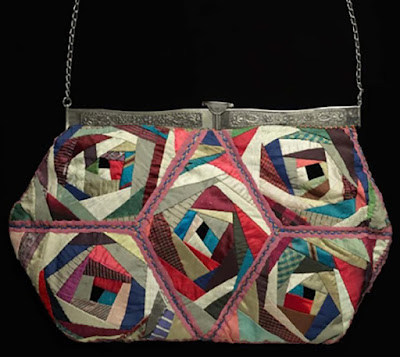Collection of the Rocky Mountain Quilt Museum, dated 1889.
Donor Anita Landess purchased it at an Illinois antique show.
See more at the Quilt Index:
We've been looking at scrap quilts at the 6KnowItAlls:ShowUsYour Quilts Facebook page this month, posting pictures of some wonderful combinations of small pieces and ingenious stitching.
Jo Reece Flowers found a silk version in North Carolina
Here's a style of very scrappy blocks without a traditional name. We can think of
them as Whirling String Quilts or as Nann said: A Cyclone of a Quilt.
The pattern is a version of a string quilt made of the smallest pieces of fabric left over from home sewing or acquired from a clothing factory.
1889 Rocky Mountain Quilt Museum
Several date-inscribed examples in the files tell us the technique was popular in the 1890s till about 1920.
1893 International Quilt Museum
1894 in silks
1898 in cottons
1905, silks with a rather free-form hexagon in the center.
1912
But here's one obviously from the 1950s
Another question: How do you make one?
Lynn Evans Miller's Collection
Mia Koerner's Collection
.jpg)
As it is a string quilt you would want to piece it over a foundation---some were pieced over scrap paper but you might want to use a square of cotton.
Block over fabric foundation
And work your way out....
What shape to start with?
Triangles
Squares
Rectangles
And some started with an irregular 5-sided piece...
Silk handbag from the collection of Boston's Museum of Fine Arts
The center shape doesn't really matter. The hard part might be to work
in a rotational manner as we are rather used to right angles.
National Museum of American History Collection
1891, attributed to Nancy Rutherford Fisher. See more about
this quilt from me and Louise:





























!E9s2fDH+DBR-IlzkJ+!~~60_57.jpg)










.jpg)










